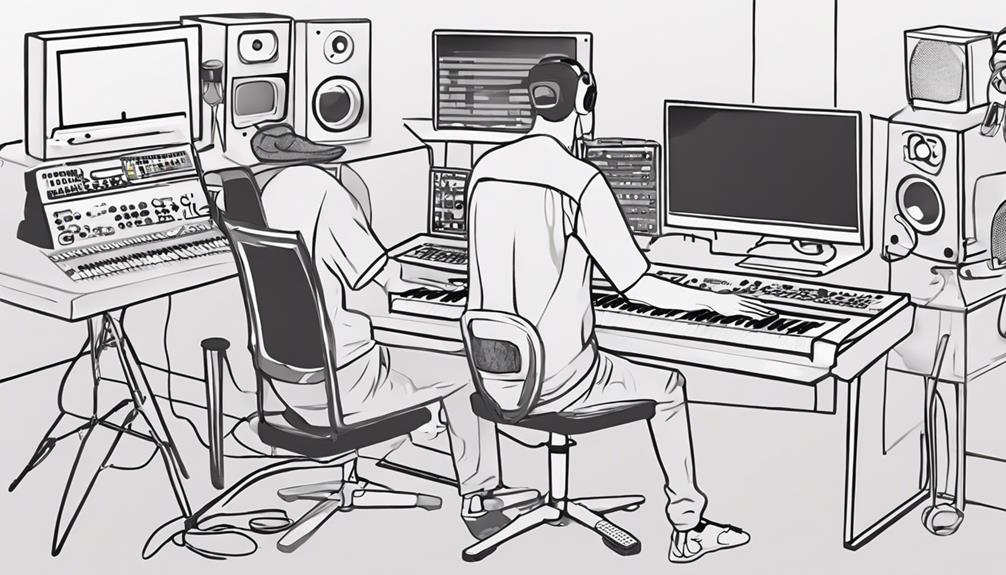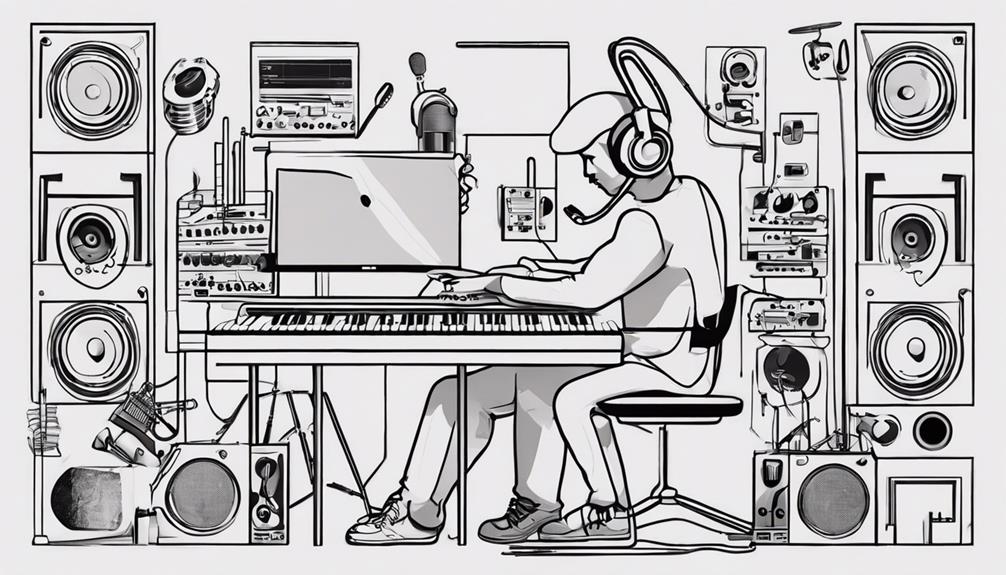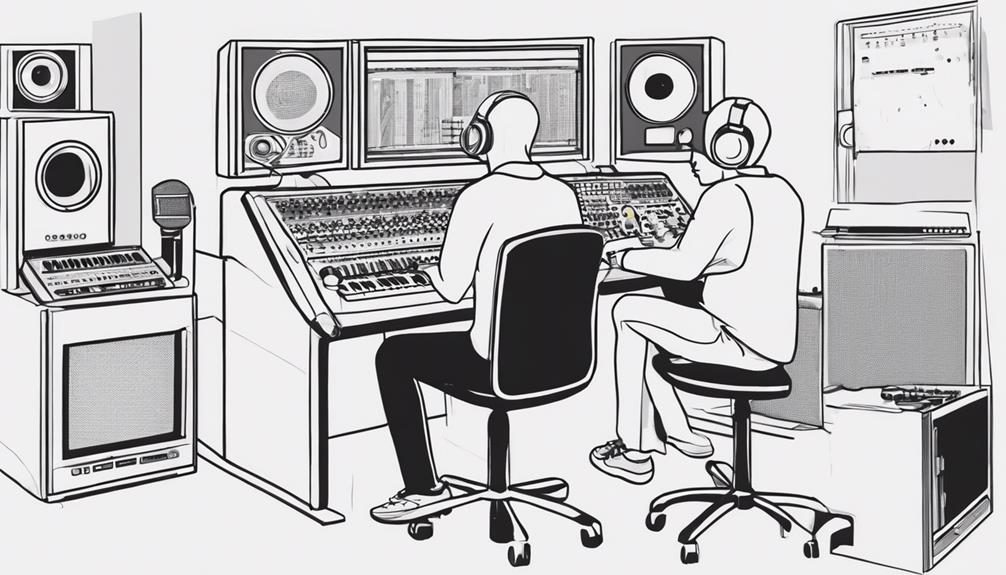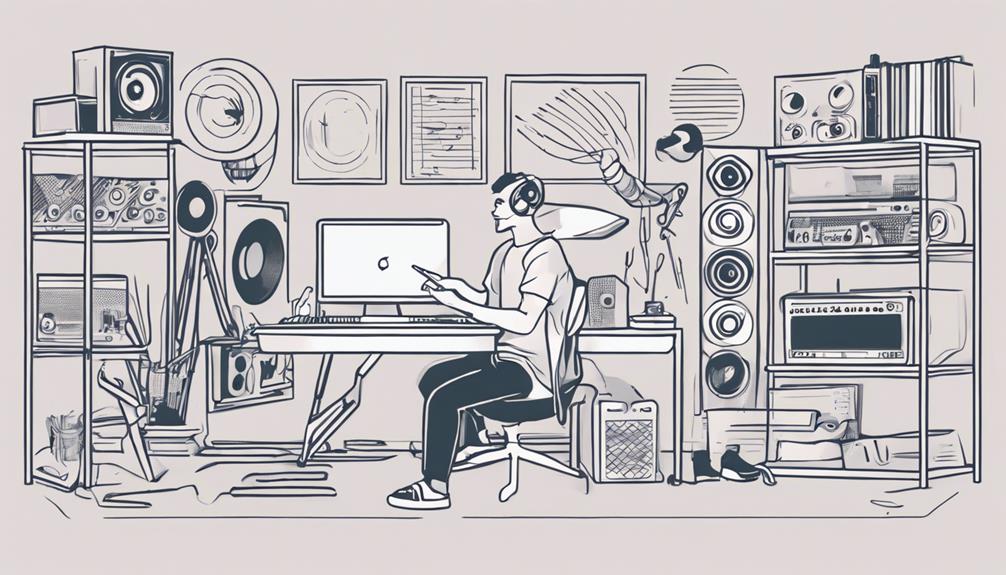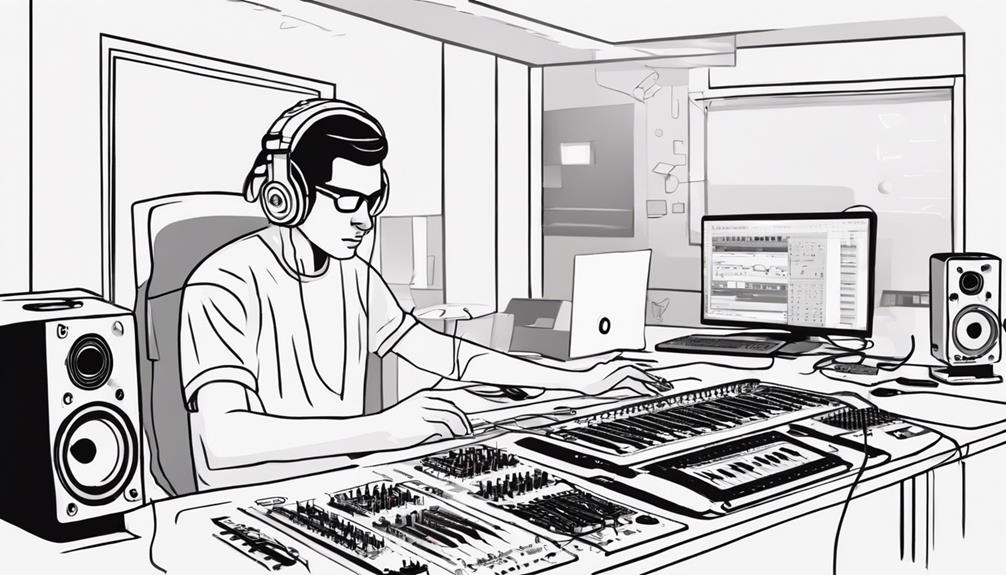To master House music production step-by-step, start by grasping core elements like basslines and beats. Choose a kick drum with a deep low-end that suits your tempo. Craft groovy bass lines using varied sounds. Explore styles like deep house for inspiration. Blend elements cohesively and establish a solid song flow. Finally, refine skills by seeking advice from seasoned producers. Mastering each step will enhance your expertise.
Key Takeaways
- Start with the core elements of house music: basslines, melodies, and beats.
- Experiment with kick drum selection and crafting distinctive bass lines.
- Explore diverse house music subgenres for inspiration and learning.
- Focus on building basic song flow and mastering track structure.
- Refine skills through online resources, workshops, collaborations, and seeking guidance.
Understanding House Music Core Elements
To grasp the essence of house music production, you must understand its core elements. House music is known for its pulsating basslines, infectious melodies, and rhythmic beats that compel you to move. At the heart of every house track lies the iconic 4-on-the-floor kick drum pattern, providing the foundation for the entire sound. This repetitive kick drum, often derived from classic drum machines like the 707, 808, or 909, drives the electronic energy that defines house music.
In addition to the kick drum, synths play an essential role in shaping the overall sound of a house track. These electronic instruments create the signature chords and melodies that give house music its vibrant and dynamic feel. Combining these elements with vocals adds another dimension, infusing the track with emotion and personality.
Understanding how these elements come together in house music production is key to crafting tracks that resonate with listeners. By mastering the art of blending bass, kick drum, synths, and vocals, you can create infectious grooves that captivate audiences and keep them dancing all night long.
Choosing the Right Kick Drum
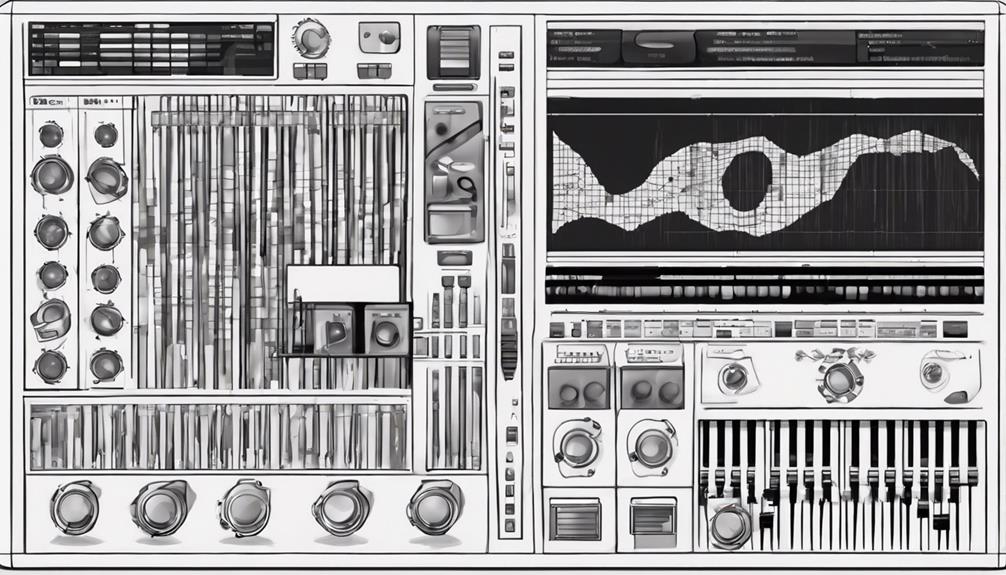
When crafting your house track, start by selecting a kick drum that packs a punch and resonates with a deep low-end.
Experiment with various samples and synthesis methods to discover the perfect sound for your production.
Keep in mind the tempo and style of your track to make sure the kick drum complements the overall vibe you want to create.
Kick Drum Selection
Consider the genre of house music you're producing when choosing the right kick drum that best complements your track's style. Whether it's deep house, tech house, or future house, the kick drum sets the foundation for your production.
Here are some tips to help you select the perfect kick drum:
- Experiment with Different Samples: Try out various kick drum samples to find one that delivers the desired punch, warmth, and energy for your track.
- Pay Attention to Details: Focus on the kick drum's attack, sustain, and tone to make sure it blends seamlessly with the overall mix and groove of your house track.
- Utilize EQ and Compression: Use EQ and compression techniques to shape and enhance the chosen kick drum sound. Adjusting frequencies can help the kick drum sit well within the mix and give it that extra oomph.
Sound Design Tips
Selecting the right kick drum sound is pivotal in shaping the overall impact and energy of your house music production. For a solid foundation, aim for a kick drum with a punchy attack and deep low-end to drive the track's groove.
Experiment with various kick drum samples to strike a balance between impact and clarity in your mix. Consider layering kick drums from different sources to add depth and create a unique sound. Pay close attention to the kick drum's frequency spectrum to make sure it complements the bassline and sits well in the overall mix.
To further enhance your kick drum sound, utilize EQ and compression techniques. Use EQ to sculpt the kick's tonal characteristics and remove any unwanted frequencies that may clash with other elements. Employ sidechain compression to help the kick drum cut through the mix without overpowering other instruments.
Crafting Distinctive Bass Lines
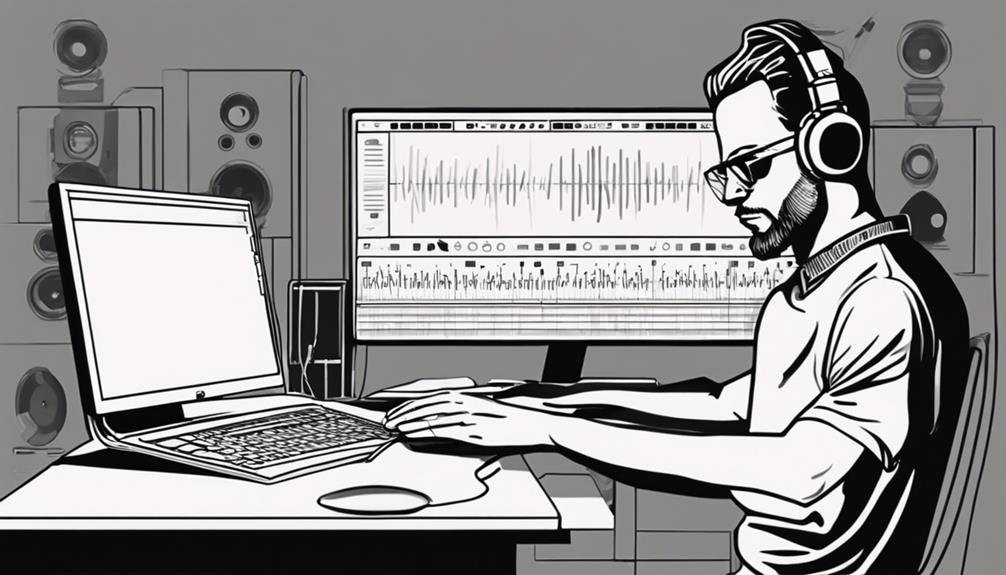
Experiment with different bass sounds to find the perfect fit for your track's vibe.
Focus on creating basslines that groove seamlessly with your kick drum rhythm.
Utilize synthesis tools for crafting unique and dynamic bass elements that elevate your house music production.
Bass Line Importance
Crafting distinctive bass lines in house music is essential for driving energy and groove throughout your track. The bass line plays a vital role in shaping the overall feel and movement of a house music production.
To make your bass line stand out and enhance the impact of your house track, consider the following:
- Experiment with Unique Bass Tones: Explore different timbres and textures to create a bass sound that complements your track's vibe and adds depth to the mix.
- Create Memorable Hooks: Craft catchy bass melodies or grooves that listeners will remember long after they've heard your track, making it more engaging and impactful.
- Ensure Cohesive Mix: Pay attention to how your bass line interacts with other elements such as drums and synths to achieve a balanced and well-integrated sound that elevates the overall production.
Melodic Variation Tips
To enhance the uniqueness of your bass lines in house music production, vary the melody by experimenting with different note lengths and rhythms. By playing around with the duration of notes and the timing of your bass line, you can create melodic variation that keeps your audience engaged.
Additionally, incorporating slides, glides, and pitch bends adds an extra layer of interest and movement to your bass melodies. These techniques help in shaping the overall feel and groove of your track.
To further enrich your sound, consider layering different bass sounds or synths to create a more complex and textured bassline. Furthermore, modulation effects such as chorus, flanger, or phaser can be used to enhance the character and depth of your bass lines.
Remember to maintain a balance between your bass line and other elements in the mix to ensure a cohesive and well-integrated sound.
Mixing Techniques for Bass
Layering different bass sounds can greatly enhance the depth and richness of your mix. To make your basslines stand out and add character to your tracks, consider the following techniques:
- Experiment with Different Bass Sounds:
Try combining organic bass samples with synthesized bass tones to create a unique and dynamic sound palette.
This combination can add texture and interest to your basslines.
- Utilize Plugins for Enhanced Depth:
Incorporate plugins like MASSIVE X to craft powerful basslines with intricate modulation and distortion effects.
These tools can help you achieve a more professional and polished sound.
- Focus on Stereo Imaging:
Pay attention to stereo imaging techniques to widen the presence of your bass in the mix.
Exploring Diverse Styles
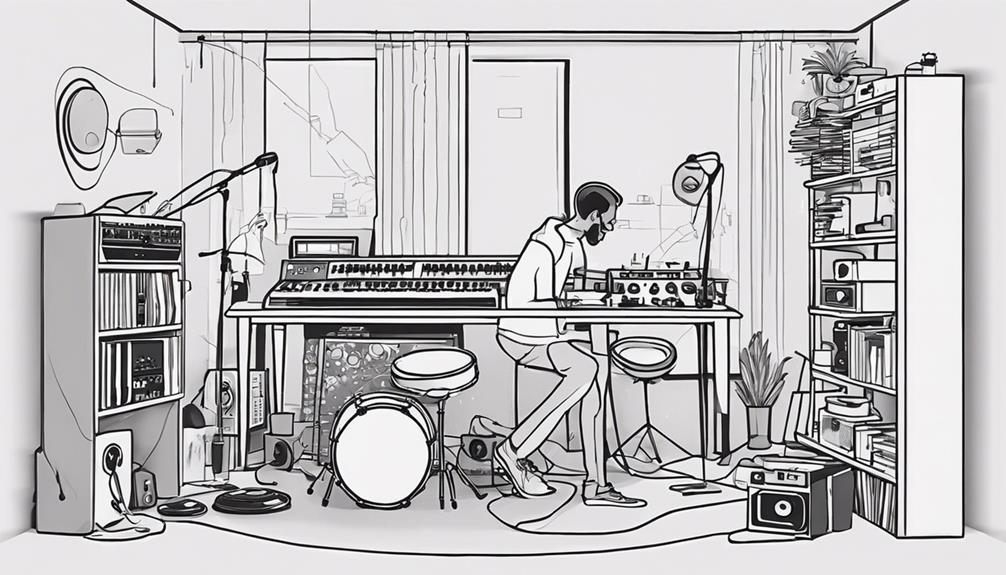
Explore the world of house music production by immersing yourself in a variety of subgenres, such as deep house, future house, and tech house. Each subgenre offers unique production techniques, sound design elements, and trends that contribute to the diverse styles within house music.
By analyzing project files from different subgenres and studying the common elements present in tracks, you can gain valuable insights into how to craft your own signature style.
Experimenting with a range of subgenres not only broadens your musical palette but also helps you develop a versatile approach to house music production. Take inspiration from the best in each subgenre to create a fusion that reflects your individuality as a producer.
Blending Elements for Cohesion
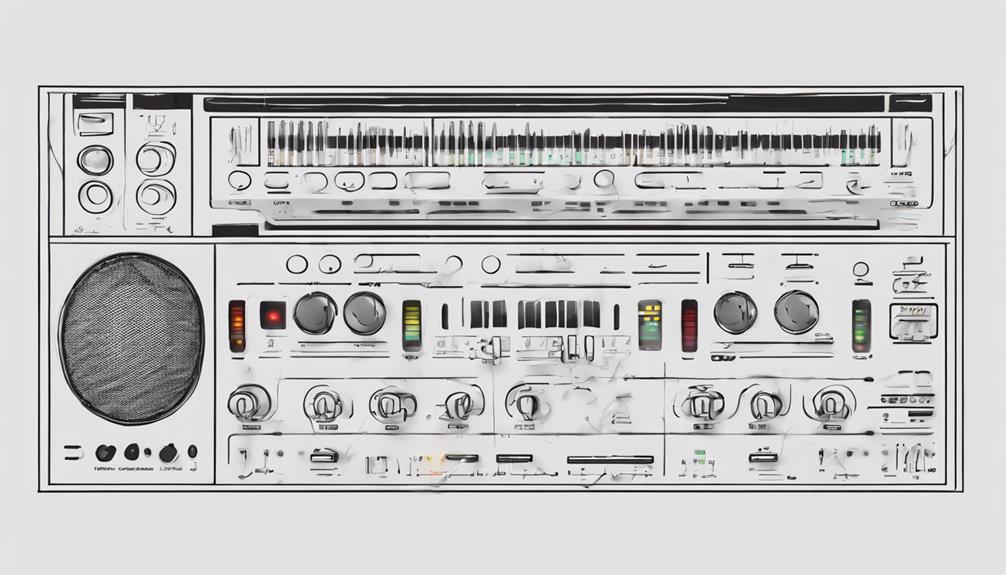
Blend drum patterns, basslines, synths, and vocals seamlessly for a cohesive sound when producing house music tracks. To achieve a unified and harmonious composition, follow these essential steps:
- Complementing Elements: Guarantee that each element, from drum patterns to vocals, complements one another to form a cohesive whole. By making sure that no single element overpowers the others, you create a balanced and engaging listening experience.
- Effective Blending Techniques: Utilize EQ, compression, and effects to blend the different elements together effectively. Experiment with these tools to find the perfect balance and create a seamless fusion of sounds.
- Attention to Detail: Pay close attention to the interaction between the various elements in your track. Through meticulous layering and mixing techniques, you can maintain cohesion throughout the entire song, resulting in a polished and professional sound.
Building Basic Song Flow
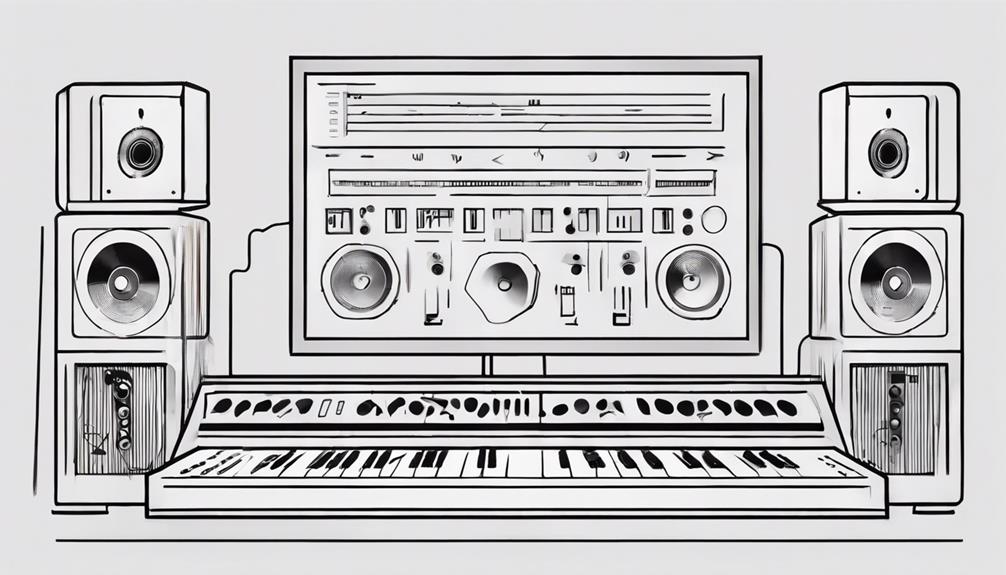
To establish a strong foundation for your house music production, prioritize mastering the structure and flow of your tracks. Begin by crafting a well-thought-out arrangement that includes essential elements like drum patterns, chord progressions, and progressions between sections.
A logical progression from the intro to the outro is vital for keeping the listener engaged. Experiment with different arrangements to maintain interest throughout the track. Study reference tracks to understand how professionals handle pacing and tension/release dynamics effectively.
Refining Skills and Seeking Advice
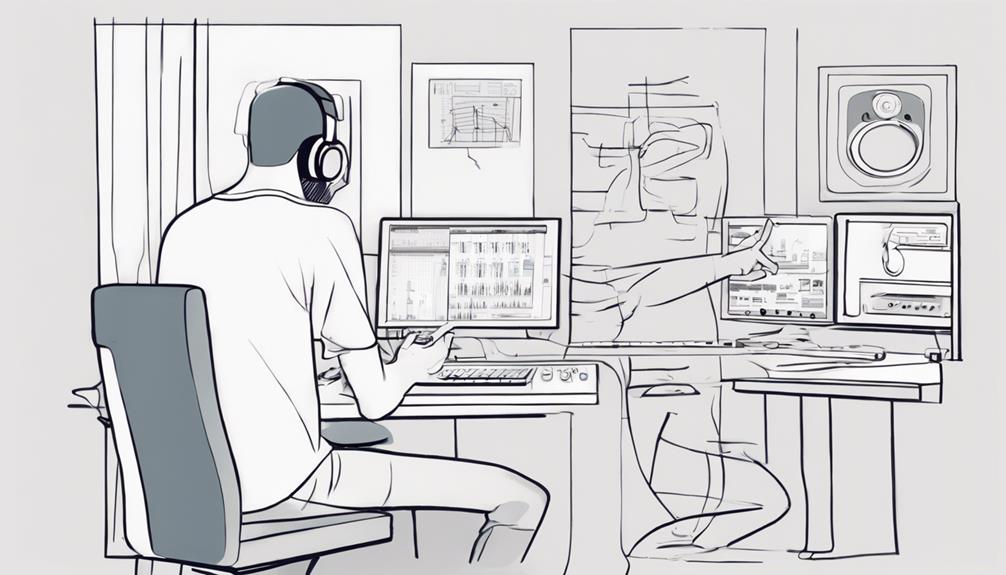
Enhance your house music production skills by seeking guidance and feedback from experienced producers. To refine your skills and seek advice in making house music, consider the following: Connect with online communities and forums where seasoned producers share tips and tricks, helping you learn the nuances of the genre. Watching tutorials and studying classic house tracks can also provide valuable insights into how to start house music production, from crafting groovy basslines to layering soulful melodies. Experiment consistently, and don’t shy away from asking for constructive criticism to sharpen your sound.
- Engage in online forums: Join platforms where you can connect with fellow producers, ask questions, and receive valuable feedback on your tracks. This interactive environment can provide fresh perspectives and insights to help you improve.
- Take online courses and tutorials: Enroll in specialized courses or follow tutorials led by industry professionals to learn new techniques and strategies. These resources can offer structured learning experiences tailored to enhance your production skills.
- Attend workshops and masterclasses: Participate in workshops or masterclasses to gain hands-on experience and valuable insights from experts in the field. These sessions can help you refine your techniques, expand your knowledge, and stay updated on industry trends.
Additionally, collaborating with other producers can provide a rich learning experience through the exchange of knowledge, ideas, and techniques for mutual growth and improvement.
Frequently Asked Questions
How to Get Good at Producing House Music?
To get good at producing house music, dive deep into drum programming, synths, basslines, and mixing. Practice 1/16 note drum patterns for that classic groove. Experiment with Serum and Massive for unique sounds. Master mixing for a polished track.
How to Make Music Production Step by Step?
Start by mastering basic music production skills. Understand house music's rhythmic elements and BPM range. Learn drum programming techniques for kick-clap rhythms. Explore synths and instrumentation for groove. Experiment with FX and mixing for a pro sound.
What Is the Formula for House Music Arrangement?
To create a solid house music arrangement, remember the structured format: intro, verses, builds, drops, breaks, and outro. Keep the track engaging by playing with tension and release. Move smoothly between sections for a pro sound.
What Is the Structure of House Music?
House music's structure is dynamic, featuring a 4/4 time signature. It includes an intro, build-up, drop, breakdown, and outro. Tracks are typically 3-4 minutes long, with extended club versions. The goal is to create tension and release for listeners.
Conclusion
Now that you've mastered the core elements of house music production, it's time to delve into the world of endless possibilities.
By carefully selecting your kick drum, crafting unique bass lines, and blending diverse styles, you'll be on your way to creating your own signature sound.
Remember, refining your skills and seeking advice along the way will only further enhance your music production journey.
Embrace the challenge and let your creativity flow!

